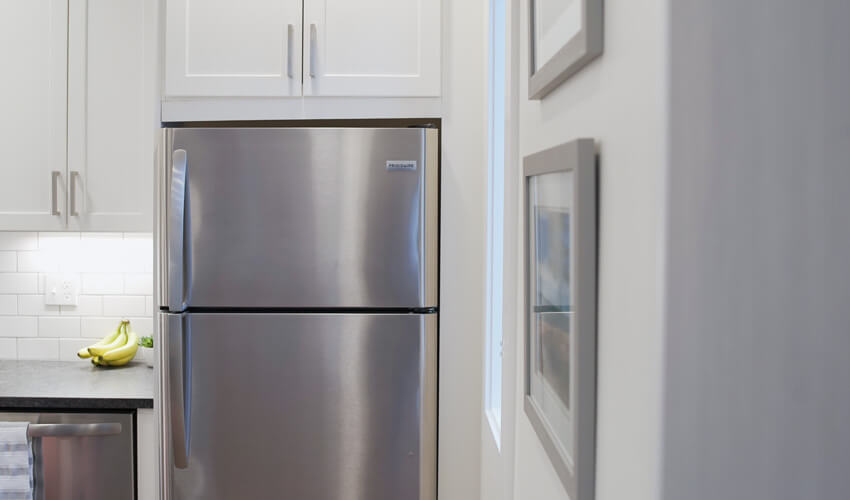Yes, you can place a dishwasher next to your fridge. Consider proper insulation and ventilation to ensure efficiency.

Designing a functional kitchen requires careful planning, especially with appliance placement. Positioning a dishwasher next to a fridge can be convenient but needs attention to detail. Proper insulation between the two appliances prevents heat transfer, maintaining efficiency. Adequate ventilation is also crucial to avoid overheating.
By considering these factors, you can create a kitchen layout that is both practical and aesthetically pleasing. This arrangement can save space and streamline your kitchen workflow, making daily tasks easier and more efficient. With the proper design considerations, placing a dishwasher next to a fridge can be a smart choice for modern kitchens.
Kitchen Layout Basics
Designing a kitchen requires careful planning. One crucial aspect is the layout. Placing appliances like dishwashers and fridges correctly impacts efficiency and space use. Let’s dive into the basics.
Workflow Efficiency
A good kitchen layout ensures smooth workflow. The triangle concept is critical here. This concept connects the sink, stove, and fridge. Each forms a point of the triangle. The goal is to minimize the steps between these points.
Placing a dishwasher next to the fridge can affect this. Think about how often you use each. You want quick access between them. This reduces the time spent moving around.
Space Utilization
Space in a kitchen is precious—every inch counts. Placing a dishwasher next to the fridge can save space. But ensure there is enough room for both to operate. Doors need to open fully without hitting each other.
Measure the available space first. Leave some clearance between the appliances. This helps with ventilation and prevents overheating.
| Appliance | Recommended Clearance |
|---|---|
| Dishwasher | 2 inches |
| Fridge | 3-5 inches |
Proper space planning ensures both efficiency and safety.
Proximity Concerns
When planning your kitchen layout, the placement of appliances is crucial. One common question is: Can you place a dishwasher next to your fridge? This section will address proximity concerns, focusing on heat and cooling effects and moisture issues.
Heat And Cooling Effects
Dishwashers generate heat during operation. Fridges need to stay calm to keep food fresh. Placing a dishwasher next to a fridge can cause the fridge to work harder. This can increase energy consumption and utility bills.
To minimize heat transfer, ensure adequate insulation between the two appliances. You can also maintain a small gap between them. This space allows for better air circulation, reducing the impact on the fridge’s cooling system.
Moisture Issues
Dishwashers release steam and moisture during cycles. Excess moisture can affect the fridge’s efficiency and lifespan. Moisture can lead to condensation, which may cause mold growth and rust.
Use proper ventilation to manage moisture levels. Installing a moisture barrier can also help. This barrier prevents steam from reaching the fridge, protecting its components.
Consider using a dehumidifier in your kitchen. This can help control overall humidity levels, making the environment safer for both appliances.
- Insulation: Adds protection against heat and moisture.
- Ventilation: Ensures air circulation to manage temperature and humidity.
- Moisture Barrier: Blocks steam and prevents damage.
- Dehumidifier: Maintains optimal humidity levels in the kitchen.
Plumbing And Electrical Requirements
Before placing a dishwasher next to your fridge, understanding the plumbing and electrical requirements is essential. Incorrect installations can lead to costly repairs and potential hazards. Follow these guidelines to ensure a safe and efficient setup.
Water Supply Lines
Ensure the dishwasher has a dedicated water supply line. This line should have a shut-off valve for easy maintenance. It is usually connected to the kitchen sink’s hot water supply.
- Use high-quality hoses for water connections.
- Check for leaks after installation.
- Ensure the water pressure is within the recommended range.
It’s crucial to avoid placing water supply lines too close to electrical outlets. This can reduce the risk of electrical shorts and water damage.
Power Outlet Placement
The dishwasher requires a dedicated power outlet. This outlet should be grounded and meet the electrical code requirements. The outlet must be easily accessible for maintenance and repairs.
Avoid placing the power outlet directly behind the dishwasher. Instead, position it in an adjacent cabinet or under the sink. This placement allows easy access without moving the appliance.
| Appliance | Recommended Distance from Power Outlet |
|---|---|
| Dishwasher | Within 4 feet |
| Fridge | Within 6 feet |
Using a GFCI (Ground Fault Circuit Interrupter) outlet is recommended for the dishwasher. This enhances safety by shutting off power during faults.
Following these plumbing and electrical requirements ensures a safe and efficient kitchen setup. Proper planning and execution can prevent issues and enhance the longevity of your appliances.
:max_bytes(150000):strip_icc()/Dishwasher-buying-tips-1907656_color_rev-619390d40de745ac99c2c2e24dc52d99.jpg)
Credit: www.thespruce.com
Ventilation Considerations
Placing a dishwasher next to a fridge might seem convenient. But it needs careful planning for proper ventilation. Both appliances generate heat and need space for air to circulate.
Air Circulation
Both the dishwasher and fridge release heat. They need space to allow air circulation. Without air circulation, they can overheat and break down.
Ensure at least 2 inches of space on each side of the fridge. The dishwasher should have a similar gap for proper air movement. This helps to keep both appliances cool and working well.
| Appliance | Recommended Space |
|---|---|
| Fridge | 2 inches on each side |
| Dishwasher | 2 inches on each side |
Avoiding Condensation
Condensation can be a big problem. It happens when warm air from the dishwasher meets the calm surface of the fridge. This can cause water droplets to form.
To avoid condensation, you can use some simple tips:
- Ensure proper sealing of both appliances.
- Use a heat-resistant barrier between them.
- Check for any leaks or faulty seals regularly.
These steps will help keep both appliances in good shape. They will also prevent any water damage to your kitchen.
Material Durability
Ensuring material durability is crucial when placing a dishwasher next to your fridge. The proximity of these two appliances exposes surrounding materials to different temperatures and moisture levels. Proper considerations can prevent potential damage and extend the life of your kitchen setup.
Countertop Resistance
Your countertop must withstand heat and moisture. Dishwashers emit steam during their drying cycle, affecting the countertop material. Choose a countertop made from heat-resistant and moisture-resistant materials such as granite or quartz.
- Granite: High heat and moisture resistance.
- Quartz: Durable and non-porous surface.
- Solid Surface: Seamless and resistant to water damage.
Cabinet Protection
Cabinets adjacent to a dishwasher need protection from steam and heat. Use water-resistant and heat-resistant materials for your cabinetry.
| Material | Properties |
|---|---|
| Plywood | Strong and moisture-resistant. |
| Thermofoil | Heat and moisture-resistant coating. |
| Solid Wood | Durable but requires proper sealing. |
Applying edge banding and sealing can further protect your cabinets. This helps to prevent water infiltration and warping.

Credit: www.mrappliance.com
Appliance Compatibility
Placing a dishwasher next to your fridge can be tricky. Ensuring appliance compatibility is crucial. This guide helps you understand the considerations.
Model Specifications
Different models have different requirements. Check the dimensions of both appliances. Ensure there is enough space for installation.
Look at the energy ratings of both appliances. Higher energy ratings mean better efficiency. Efficient models generate less heat.
Manufacturer Guidelines
Manufacturers often provide specific installation guidelines. Always refer to the user manual. It contains important installation instructions.
Some brands may recommend minimum clearance between appliances. Adhering to these guidelines prevents issues. It ensures both appliances work well together.
| Appliance | Minimum Clearance | Energy Rating |
|---|---|---|
| Dishwasher | 2 inches | A++ |
| Fridge | 2 inches | A+ |
- Consult the user manual for both appliances.
- Check the energy ratings for efficiency.
- Ensure adequate clearance to prevent overheating.
Aesthetic Balance
Placing a dishwasher next to your fridge can seem challenging. Achieving an aesthetic balance is crucial for a harmonious kitchen. The right design choices make your space look organized and pleasing.
Visual Harmony
Visual harmony is key in creating a balanced kitchen look. Ensure appliance sizes match or complement each other. A large fridge next to a small dishwasher looks off-balance. Align the top edges of both appliances to create a cohesive line.
Consider the materials and finishes of your appliances. Stainless steel appliances often blend well together. Matte finishes provide a uniform look, reducing visual clutter.
Color Coordination
Color coordination plays a big role in aesthetic balance. Choose appliances in similar colors or finishes. If your fridge is white, a white dishwasher creates a seamless look.
Incorporate the colors of your cabinetry and countertops. Use a color palette that ties everything together. Neutral colors like grey, white, or black are safe choices. They match most kitchen designs and create a clean look.
For a more vibrant kitchen, consider bold colors. Ensure these colors complement each other to avoid visual chaos. A bright red fridge can pair well with a red or black dishwasher.
| Aspect | Tip |
|---|---|
| Appliance Size | Ensure sizes match or complement each other. |
| Materials and Finishes | Use similar materials and finishes for uniformity. |
| Color Palette | Choose colors that tie the kitchen design together. |
- Match appliance sizes for visual harmony.
- Align top edges for a cohesive look.
- Use similar finishes to reduce visual clutter.
- Choose a color palette that matches your kitchen.
- Ensure appliance sizes match.
- Align top edges.
- Use similar materials and finishes.
- Choose a cohesive color palette.

Credit: www.kitchenaid.com
Expert Tips
Placing a dishwasher next to a fridge can be tricky. Expert tips can help. Follow these guidelines to ensure a functional kitchen layout.
Professional Advice
Experts suggest keeping some distance between appliances. The heat from the dishwasher can affect the fridge. Leave at least 2 inches of space. This helps with airflow and prevents overheating.
Use insulation materials. Insulate the space between the fridge and dishwasher. This helps maintain the fridge’s efficiency. Consider using a heat-resistant barrier.
Ensure proper ventilation. Both appliances need good ventilation to work well. Check manufacturer instructions for specific requirements.
| Consideration | Recommendation |
|---|---|
| Distance | At least 2 inches |
| Insulation | Use heat-resistant materials |
| Ventilation | Follow manufacturer guidelines |
Common Mistakes
Avoid placing the dishwasher directly next to the fridge. This can cause performance issues. Heat from the dishwasher can make the fridge work harder.
Do not neglect insulation. Lack of insulation can lead to higher energy bills. It can also reduce the lifespan of both appliances.
Ensure there is enough space for both appliances to ventilate. Crowding can lead to overheating. Make sure to leave adequate gaps.
- Avoid direct contact between the appliances.
- Insulate properly to save energy.
- Allow enough space for ventilation.
Following these expert tips can improve your kitchen design. It will also extend the life of your appliances.
Frequently Asked Questions
Can a Dishwasher Be Right Next to a Fridge?
Yes, a dishwasher can be placed next to a fridge. Ensure proper ventilation and insulation to prevent heat transfer.
How Far Should the Fridge Be From the Dishwasher?
Keep the fridge at least 2-3 inches from the dishwasher. This ensures proper airflow and prevents overheating.
Where Should Your Dishwasher Be Located?
Place your dishwasher near the sink for easy access to water lines and drainage. Ensure there’s enough space for loading and unloading. Avoid locations that block walkways or kitchen work areas. Proximity to storage for dishes and utensils is ideal.
How Much Clearance Do You Need on the Sides of a Dishwasher?
You need at least 2 inches of clearance on both sides of a dishwasher for proper installation and ventilation.
Conclusion
Placing a dishwasher next to your fridge can work with careful planning. Ensure proper ventilation and spacing. Use water-resistant materials to avoid damage. Consult professionals for best results. These steps will help you create a functional and stylish kitchen. Embrace these design tips for an efficient and harmonious space.


GIPHY App Key not set. Please check settings